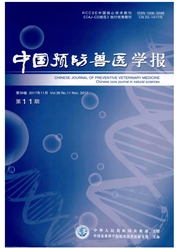

 中文摘要:
中文摘要:
为了解猪丹毒在安徽地区的流行特征和再发原因以及临床防治的敏感药物,本研究针对2012年-2015年安徽地区发生的猪丹毒进行流行病学调查,对分离菌株进行吖啶黄敏感性试验以及微量肉汤稀释法测定最小抑菌浓度(MIC)。结果显示,在合肥、六安、安庆、蚌埠等地猪丹毒发生率较高,7月-9月为高峰期,主要集中于育肥阶段(61.9%),以急性败血症型为主(92.9%)。42株分离菌株虽对青霉素(PEN)、氨苄青霉素(AMP)、头孢噻肟(CTX)、头孢曲松(CRO)等抗生素的敏感率均高于80%,但耐受5种及以上抗菌药物的比例达95.2%,其中耐庆大霉素(GEN)+卡那霉素(KAN)+链霉素(STR)+克林霉素(CLI)+林肯霉素(LIN)占81%。有4株可以在含0.02%吖啶黄的脑心浸液培养基(BHI)琼脂平板上生长。结果表明,安徽地区猪丹毒呈散发性或地方性流行,多发生于夏秋季节,临床特征多为育肥猪的急性败血症,青霉素类药物仍是防治猪丹毒的首选药物。本研究揭示安徽地区猪丹毒再发原因与弱毒菌苗株可能的毒力返强无关,并为该地区猪丹毒的有效防控提供科学依据。
 英文摘要:
英文摘要:
This study was aimed to investigate the prevalence and recurrent causes of Etysipelothrix rhusiopathiaein Anhui areas and the sensitive drugs to E.rhusiopathiae. We conducted epidemiological investigations of E.rhusiopathiae in Anhui areas from 2012 to 2015, sensitivity tests of Erysipelothrix isolates to acridine yellow, and broth microdilution technique to determine MIC. Results showed that higher incidences of E.rhusiopathiae were in the regions of Hefei, Lu'an, Anqing, and Bengbu, peaked in July and September, and clustered at the end of Erysipelothrix isolates to PEN, AMP, CTX, CRO, CIPENR, GAT and CHL were higher than 80%, 95.2% of the Erysipelothrix isolates were resistant to five or more antibiotics with the proportion 81% of the isolates to be GEN+KAN+STR+CLI+LIN, and four Erysipelothrix isolates were able to grow on the BHI agar plate that contained 0.02% acridine yellow. The conclusion was that E.rhusiopathiae had scattering and local prevalence in Anhui areas, and peaked in summer and fall with acute septicemia as the primary clinical symptom of fattening pigs. PEN was still the preferred drug for the prevention and treatment of E.rhusiopathiae. There was no evidence that the recurrence of E.rhusiopathiae in Anhui areas was associated with the virulence reversion of vaccine strains administrated in the pig farms .
 同期刊论文项目
同期刊论文项目
 同项目期刊论文
同项目期刊论文
 期刊信息
期刊信息
